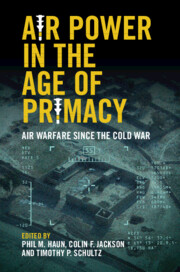Book contents
- Air Power in the Age of Primacy
- Air Power in the Age of Primacy
- Copyright page
- Contents
- Figures
- Tables
- Contributors
- Preface
- Abbreviations
- 1 Air Power in the Age of Primacy
- 2 Remote Warfare: A New Architecture of Air Power
- 3 Deliberate Force: Ambivalent Success
- 4 Hoping for Victory: Coercive Air Power and NATO’s Strategy in Kosovo
- 5 Operation Enduring Freedom
- 6 The Result Is Never Final: Operation Iraqi Freedom
- 7 Israeli Air Force Effectiveness during the Second Lebanon War (2006)
- 8 Libya 2011: Hollow Victory in Low-Cost Air War
- 9 Coercing a Chaos State: The Saudi-Led Air War in Yemen
- 10 Russia’s Air War Win in Syria
- 11 Air Power in the Battle of Mosul
- 12 Retrospect and Prospect: Air Power in the Age of Primacy and Beyond
- Index
1 - Air Power in the Age of Primacy
Air Warfare since the Cold War
Published online by Cambridge University Press: 16 December 2021
- Air Power in the Age of Primacy
- Air Power in the Age of Primacy
- Copyright page
- Contents
- Figures
- Tables
- Contributors
- Preface
- Abbreviations
- 1 Air Power in the Age of Primacy
- 2 Remote Warfare: A New Architecture of Air Power
- 3 Deliberate Force: Ambivalent Success
- 4 Hoping for Victory: Coercive Air Power and NATO’s Strategy in Kosovo
- 5 Operation Enduring Freedom
- 6 The Result Is Never Final: Operation Iraqi Freedom
- 7 Israeli Air Force Effectiveness during the Second Lebanon War (2006)
- 8 Libya 2011: Hollow Victory in Low-Cost Air War
- 9 Coercing a Chaos State: The Saudi-Led Air War in Yemen
- 10 Russia’s Air War Win in Syria
- 11 Air Power in the Battle of Mosul
- 12 Retrospect and Prospect: Air Power in the Age of Primacy and Beyond
- Index
Summary
Since the end of the Cold War there has been an age of primacy marked by a series of conflicts for which powerful states have chosen to go to war over nonvital interests against much weaker state or nonstate actors. In these asymmetric conflicts, the powerful have coerced concessions, imposed regime change, and suppressed the spread of violence through counterterrorism or counterinsurgency operations. Powerful nations have largely succeeded in achieving both their military and political objectives by taking advantage of asymmetries in technology to wage war from afar, at low risk to their own forces. War outcomes have not, however, always translated into broader foreign policy objectives of long-term peace and stability. This introductory chapter provides an overview of the evolution of air power theory, presents characteristics of contemporary air warfare and measures of military and political effectiveness, and then briefly assesses the ten air wars examined in subsequent chapters.
Keywords
- Type
- Chapter
- Information
- Air Power in the Age of PrimacyAir Warfare since the Cold War, pp. 1 - 25Publisher: Cambridge University PressPrint publication year: 2021

